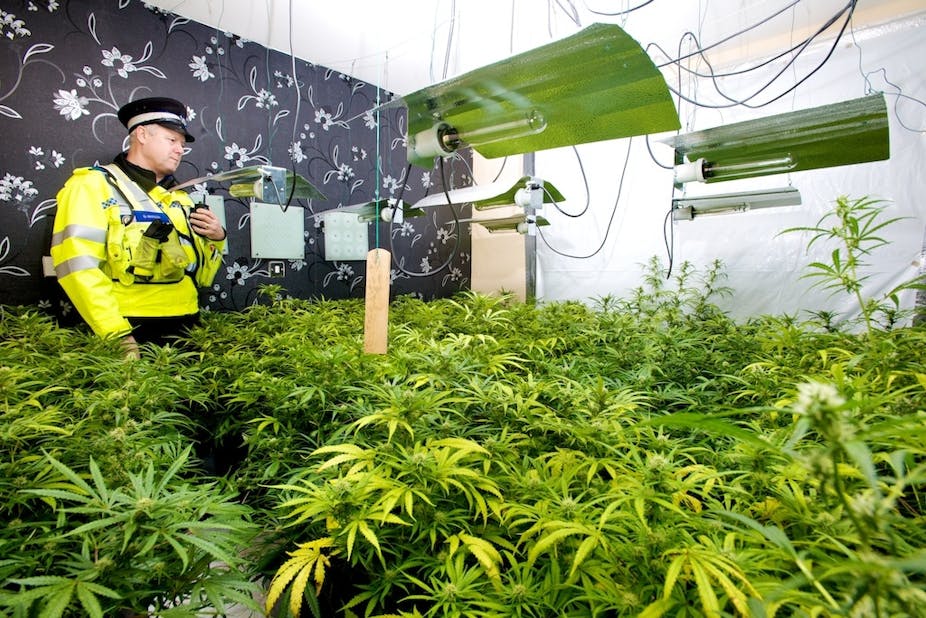The mantra “war against drugs” sounds great from a distance, but on closer inspection, it’s a misleading, sweeping generalisation.
There are, in fact, many different, contradictory and inconsistent policies on drug use control. These represent uneasy compromises driven by conflicting ideologies in our society.
Conflicts arise over the perceived damage the drugs might do, the amount of effort required to control the drug, and how accepted the drug is within sections of our society.
Let’s look at each drug in turn.
Deadly smoke

Most – 80% – of drug-related deaths are a result of diseases caused by tobacco. Through changing social attitudes and legislation, we’ve been able to reduce the prevalence of smoking, reduce the harm from smoking and improve community health.
The conflict has been considerable, as the current high court challenge of the Australian government by the tobacco giants illustrate. And, we now have huddles of addicts stand outside public buildings, creating a cloud of smoke to welcome visitors.
At the bottom of the glass

Alcohol, our favourite drug, is also subject to policy control. These have undergone considerable liberalisation in the last 20 years, but widespread availability is tough for alcoholics, whose recovery is made more difficult by being surrounded by supermarket liquor outlets.
There’s enormous political resistance to taxing alcohol according to alcoholic content. While this would slug the wine industry, it would reduce the overall consumption of alcohol and improve public health.
The rise and rise of opioids
Policies on opioids such as morphine (good) and heroin (bad) show major inconsistencies. If the person is addicted to injecting heroin, they can reduce the harm of their addiction by attending a needle and syringe exchange program. Such an enlightened policy has reduced the spread of blood-borne viruses, especially HIV/AIDS, although it has had less success in reducing the spread of hepatitis C.
But we’ve had difficulty with further harm minimisation strategies. Safe injecting rooms are controversial. The experiment at Kings Cross in Sydney has finally been declared successful enough to be an ongoing funded program. Users can attend a safe injecting room where they can inject a dirty drug within a clean and safe environment.
But how do users in Cabramatta (within the same greater metropolitan area) cope with no such facilities? And in Victoria, the injecting facility canvassed for Richmond has been blocked by the Victorian state government for no sound scientific reason.
Addicts sick of their injecting can opt for substitution pharmacotherapy. This option is supported by a considerable body of scientific evidence but decried by drug-free society advocates, who claim the approach is promoted by the medico-pharmaceutical cartel.

Those who decide to use these drugs need to find a medical prescriber trained in the management of substitution pharmacotherapy, but there’s a shortage of trained practitioners, and it can be difficult to get on a program.
If someone can persuade any doctor that they have chronic pain rather than opioid dependence, they can have an even wider range of opioids – oxycodone, slow-release oral morphines and the like. The dispensing of these agents is much more liberal and patients don’t have to pay the dispensing fee. As one wag put it, “The only opioid dependent persons on substitution pharmacotherapy are those not clever enough to persuade their doctors they have chronic pain.”
It’s not surprising then, that in the last 15 years we’ve seen a huge rise in use of prescription opioids in the community. These drugs are prescribed and dispensed by doctors and pharmacists untrained in opioid prescribing.
Xanax and its relations
Drugs such as Valium and Xanax are all part of a family called benzodiazepines. Initially, these drugs were freely prescribed to treat insomnia and anxiety, because they were much safer in overdose than the barbiturates they replaced. But as the medical professions recognized their addictive potential, they became more careful in their prescribing. Now, a black market has opened up on these drugs.
Add to this the availability of drugs on the internet from potentially unreliable sources, and a whole new dimension of drug availability and control has developed.
And then there’s cannabis

The debate on cannabis is becoming intense, with pro and anti-groups lobbying hard. Different states in Australia take somewhat different positions. The key question is whether the effort needed to control the drug is disproportionate to its harm.
Cannabis’ ability to precipitate psychosis in the vulnerable is increased with greater potency, although, for the bulk of users, the drug is a weekend escape from the pressures of life.
Stimulants of all sorts

Many Australia cities now proudly boast that they’re sophisticated coffee cities. No one would dream of curtailing the streams of coffee, and for many it’s a daily addiction.
Cocaine is the rich man’s coffee. Driven professionals, seeking to meet impossible deadlines, find stimulants useful, as do those using it socially at clubs or music festivals. Speed is more downmarket, but both these drugs can have long-term detrimental effects. And people on these drugs can show considerable psychological instability.
Where to now
This brief survey shows the mix of different responses to different addictive agents. The unscrupulous will usually find a way of exploiting the vulnerable and social controllers will always want to impose their values onto the rest of society.
We have to live with the resultant compromises. The problem will not go away and open slather is not the answer. In the end, if users learn to internalise their own control and feel able to replace the perceived benefits of these drugs with safer alternatives, we can reduce the demand and dry up the profits of those importing, making and selling these agents.

